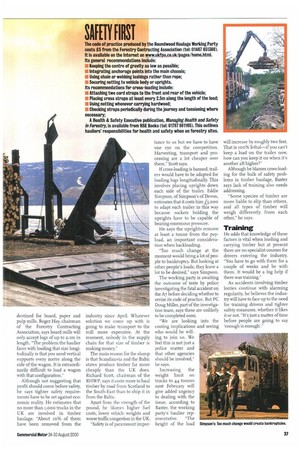A code of practice produced by the Roundwood Haulage Working
Page 38

Page 39

If you've noticed an error in this article please click here to report it so we can fix it.
Party (RHWP), which is made up of contractors, growers and processors, covers all aspects of safety in timber haulage. Its recommendations include straps along the length and breadth of any cross-load and, in some cases, netting as well.
The code is not legally binding and, according to Dinwoodie, it was universally ignored before the accident. Since then Forest Enter
prise, which manages all publiclyowned forests, has warned that hauliers will be banned from its sites in southern Scotland for any serious breaches.
Alistair Baxter, managing director of Midlothian-based James Baxter & Sons and the haulier representative on the working party, says there have still been several more accidents involving timber falling off flatbeds. "There are still a lot of hauliers not tying down loads in the recommended way," he says.
Llandrindod Wells-based Kenny Williams says there are numerous examples of cross-loads being shed in Wales as well. "People are loading 4oft trailers front to back. It is totally wrong; you can never strap it firmly in place."
Earlier this summer, a crossloaded log from a vehicle owned by Owen James of Llandovery hit a passing Land Rover Discovery travelling along the A483. James says he only cross-loads occasionally and always restricts it to the middle section of trailers. He blames the accident on an overhanging branch which nudged the log off when the driver pulled in close to the curb to avoid a passing lorry. "We only load logs that way if we're low on the payload," he says.
Banning cross-loading would have enormous implications for the timber industry. The system is used mainly for small, less valuable cuts of timber which are
destined for board, paper and pulp mills. Roger Hay, chairman of the Forestry Contracting Association, says board mills will only accept logs of up to 2.1111 in length. "The problem the haulier faces with loading that size longitudinally is that you need vertical supports every metre along the side of the wagon. It is extraordinarily difficult to load a wagon with that configuration:
Although not suggesting that profit should come before safety, he says tighter safety requirements have to be set against economic reality. He estimates that no more than ',ciao trucks in the UK are involved in timber haulage. "About to% of them have been removed from the industry since April. Whatever solution we come up with is going to make transport to the mill more expensive. At the moment, nobody in the supply chain for that size of timber is making money."
The main reason for the slump is that Scandinavia and the Baltic states produce timber far more cheaply than the UK does. Richard Scott, chairman of the RHWP, says it costs more to haul timber by road from Scotland to the South-Fast than to ship it in from the Baltic.
Apart from the strength of the pound, he blames higher fuel costs, lower vehicle weights and worse traffic congestion in the UK.
"Safety is of paramount impor
tance to us but we have to have one eye on the competition. Harvesting, transport and processing are a lot cheaper over there," Scott says.
If cross-loading is banned, trailers would have to be adapted for loading logs longitudinally. This involves placing uprights down each side of the trailer. Eddie Simpson, of Simpson's of Devon, estimates that it costs him L5,000 to adapt each trailer in this way because sockets holding the uprights have to be capable of bearing enormous pressure.
He says the uprights remove at least a tonne from the payload, an important consideration when backloading.
"Too much change at the moment would bring a lot of people to bankruptcy. But looking at other people's loads, they leave a lot to be desired," says Simpson.
The working party is awaiting the outcome of tests by police. investigating the fatal accident on the A7 before deciding whether to revise its code of practice. But PC Doug Miller, part of the investigation team, says these are unlikely to be completed soon.
Increasing the weight limit on trucks to 44 tonnes next February will give added urgency to dealing with the issue, according to Baxter, the working party's haulier rep resentative. "The height of the load will increase by roughly two feet. That is t00% lethal—if you can't keep a load on the trailer now, how can you keep it on when it's another 2ft higher?"
Although he blames cross-loading for the bulk of safety problems in timber haulage, Baxter says lack of training also needs addressing, "Some species of timber are more liable to slip than others, and all types of timber will weigh differently from each other," he says.
Training
He adds that knowledge of these factors is vital when loading and carrying timber but at present there are no specialist courses for drivers entering the industry. "You have to go with them for a couple of weeks and be with them. It would be a big help if there was training."
As accidents involving timber lorries continue with alarming regularity, he believes the industry will have to face up to the need for training drivers and tighter safety measures, whether it likes it or not. "It's just a matter of time before people are going to say 'enough is enough':








































































































